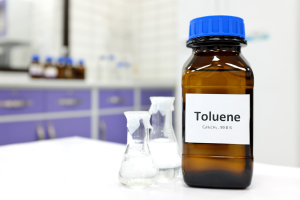Toluene is a popular solvent used in paints, varnishes and cleaning products, but these are not all of its applications. Some of them may be really surprising! What is toluene and in what products is it used?

What is toluene?
Toluene (also known as methylbenzene or phenylmethane) is an organic compound belonging to the group of aromatic hydrocarbons. Its summary formula is C7H8. It is a transparent liquid with an intense odour that is perceived as pleasant by most people. Few know that the discoverer of toluene was a young Polish chemist, Filip Walter, who lived in the 19th century.
Toluene is mainly used as a solvent, which is possible thanks to its properties. It is insoluble in water, but combines well with other substances, e.g. with most organic solvents.
How is toluene produced?
Toluene is most often produced from petroleum during the process of catalytic reforming. Another way to obtain it is through fractional distillation of coal tar. Interestingly, toluene can also be made from plants, namely from Myroxylon balsamum, a tree that grows in South America. The substance is obtained by distillation of balsam of Peru, which a resin exuded from cuts in the bark.
Physicochemical properties of toluene
Toluene is a liquid with a density of 0.8623 g/cm³ (20°C). It has a boiling point close to that of water at approx. 110°C, but its melting point is much lower at -94.95°C.
It is flammable and burns with a yellow flame producing a lot of smoke. When storing toluene-containing products it is important to keep them away from heat sources.
Toluene does not mix with water. Its solubility in water is 0,54 g/kg. On the other hand, it mixes well with ethanol and ether and is soluble in acetone and carbon disulphide. Thanks to these characteristics, toluene is widely used in many areas of the economy.

Toluene applications – what are its industrial applications?
Toluene is used:
- as a solvent in paints, varnishes, corrosion inhibitors;
- as an ingredient in gels, sprays, hair dyes, detergents and disinfectants;
- in the production of medicines, dyes, rubber, resins;
- as a substrate to synthesise common chemicals: trinitrotoluene, benzoic acid, toluene diisocyanate;
- for the production of explosives, primarily TNT;
- in liquid-in-glass minimum thermometers (which measure the lowest temperature during a day) and in high-octane aviation fuels – because of their low freezing point.
Toluene and safety How to handle products containing this substance?
The physical and chemical properties of toluene allow it to be used in many ways, but one must remember that it is a substance which is very toxic and dangerous to health. People can be exposed to toluene primarily at the production stage but also during the use of products containing this compound. Special precautions should be taken when applying paints or varnishes and when using cleaning products.
Toluene is harmful to the respiratory, reproductive, vascular and nervous systems, as well as to liver and kidneys. Inhalation, ingestion and direct contact with the skin are particularly dangerous, as they may lead to acute poisoning. People who are exposed to toluene at work, e.g. during the production of paints, varnishes or detergents, are also at risk of chronic poisoning.
Under the European Union’s CLP Regulation, toluene is classified as flammable (F) and harmful (Xn). In addition, according to the Polish Act on prevention of drug abuse, it is a category 3 drug precursor. However this does not mean that toluene is particularly dangerous – this category consists of substances that have little potential for being used in the production of drugs.
- https://www.britannica.com/science/toluene
- https://www.cdc.gov/niosh/idlh/108883.html
- https://pubchem.ncbi.nlm.nih.gov/compound/Toluene
- https://www.osha.gov/toluene